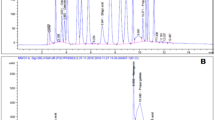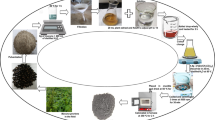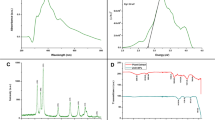Abstract
Salvadora persica extract was utilized as a mediate in the synthesis of zinc oxide nanoparticles (ZnO-NPs) under ambient conditions. The biosynthesized particles were characterized via UV-Vis, PXRD, FESEM, EDX, DLS, Raman, and FT-IR analysis. The UV-Vis studies of these particular nanoparticles revealed a characteristic peak at 383 nm, and PXRD pattern presented wurtzite structure (hexagonal) for the synthesized ZnO-NPs, suggesting the formation of ZnO nanoparticles. The FESEM image indicated that the biosynthesized particles were uniformly shaped in hexagonal with the average size of 60–130 nm at calcination temperatures of 500, 600, and 700 °C. On the other hand, the EDX clearly exhibited the presence of Zn and O elements in the biosynthesized sample. The powder x-ray diffraction (PXRD) and Raman studies confirmed the formation of single crystalline, hexagonal wurtzite ZnO structures. The cytotoxic activity of the biosynthesized nanoparticles against HT-29 cancer cell line was examined through MTT assay. The results indicated that the toxicity of synthesized nanoparticles is dependent on the concentration of nanoparticles.









Similar content being viewed by others
References
Huang, K., Ma, H., Liu, J., Huo, S., Kumar, A., Wei, T., Zhang, X., Jin, S., Gan, Y., Wang, P. C., He, S., Zhang, X., & Liang, X. J. (2012). Size-dependent localization and penetration of ultrasmall gold nanoparticles in cancer cells, multicellular spheroids, and tumors in vivo. ACS Nano, 6, 4483–4493.
Bisht G., Rayamajhi S. (2016). ZnO nanoparticles: a promising anticancer agent. Nanobiomedicine, 3, 1-11.
Wahab, R., Siddiqui, M. A., Saquib, Q., Dwivedi, S., Ahmad, J., Musarrat, J., Al-Khedhairy, A. A., & Shin, H. S. (2014). ZnO nanoparticles induced oxidative stress and apoptosis in HepG2and MCF-7 cancer cells and their antibacterial activity. Colloids and Surfaces. B, Biointerfaces, 117, 267–276.
Salari, Z., Ameri, A., Forootanfar, H., Adeli-Sardou, M., Jafari, M., Mehrabani, M., & Shakibaie, M. (2017). Microwave-assisted biosynthesis of zinc nanoparticles and their cytotoxic and antioxidant activity. Journal of Trace Elements in Medicine and Biology, 39, 116–123.
Miri, A., Sarani, M., Rezazade Bazaz, M., & Darroudi, M. (2015). Plant-mediated biosynthesis of silver nanoparticles using Prosopis farcta extract and its antibacterial properties. Spectrochimica Acta. Part A, Molecular and Biomolecular Spectroscopy, 141, 287–291.
Khatami, M., Alijani, H. Q., Nejad, M. S., & Varma, R. S. (2018). Core@shell nanoparticles: greener synthesis using natural plant products. Applied Sciences, 8, 411.
Miri, A., Darroudi, M., Entezari, R., & Sarani, M. (2018). Biosynthesis of gold nanoparticles using Prosopis farcta extract and its in vitro toxicity on colon cancer cells. Research on Chemical Intermediates, 44, 3169–3177.
Khatami, M., Alijani, H. Q., & Sharifi, I. (2018). Biosynthesis of bimetallic and core shell nanoparticles: their biomedical applications: a review. IET Nanobiotechnol, 12, 879–887.
Miri, A., Dorani, N., Darroudi, M., & Sarani, M. (2016). Green synthesis of silver nanoparticles using Salvadora persica L. and its antibacterial activity. Cellular and Molecular Biology, 62, 46–50.
Khatami, M., Heli, H., Jahani, P. M., Azizi, H., & Nobre, M. A. L. (2017). Copper/copper oxide nanoparticles synthesis using Stachys lavandulifolia and its antibacterial activity. IET Nanobiotechnol, 11, 709–713.
Miri, A., & Sarani, M. (2018). Biosynthesis, characterization and cytotoxic activity of CeO2 nanoparticles. Ceramics International, 44, 12642–12647.
Arora, M., & Gupta, V. K. (2011). Phytochemical and biological studies on Salvadora persica wall: a review. Pharmacologyonline, 1, 591–601.
Yadav, J., Saini, S., & Kalia, A. (2005). Botanical, cytological, phytochemical and pharmacognostical studies on Salvadora species. Journal of Medicinal Plant Sciences, 2, 231–238.
Halawany, H. S. (2012). A review on miswak (Salvadora persica) and its effect on various aspects of oral health. Saudi Dental Journal, 24, 63–69.
Hafiz, U., Hafiz, A., Momin, A., & Dawoodbhoy, R. (2016). Effects of Salvadora persica on oral health: a birds eye view. IJPCDR, 3, 271–276.
Halib, N., Nuairy, N. B., Ramli, H., Ahmad, I., Othman, N. K., Salleh, S. M., & Bakarudin, S. B. (2017). Preliminary assessment of Salvadora persica whitening effects on extracted stained teeth. Journal of Applied Pharmaceutical Science, 7, 121–125.
Deswal, H., Singh, Y., Grover, H. S., Bhardwaj, A., & Verma, S. (2016). Miswak as an alternative treatment modality in medicine and dentistry: a review. Innovare Journal of Life Sciences, 4(2), 6–8.
Nava, O. J., Luque, P. A., Gómez-Gutiérrez, C. M., Vilchis-Nestor, A. R., Castro-Beltrán, A., Mota-González, M. L., & Olivase, A. (2017). Influence of Camellia sinensis extract on zinc oxide nanoparticle green synthesis. Journal of Molecular Structure, 1134, 121–125.
Khatami, M., Sharifi, I., Nobre, M. A. L., Zafarnia, N., & Aflatoonian, M. R. (2017). Waste-grass-mediated green synthesis of silver nanoparticles and evaluation of their anticancer, antifungal and antibacterial activity. Green Chemistry Letters and Reviews, 11(2), 125–134.
Alwan, R. M., Kadhim, Q. A., Sahan, K. M., Ali, R. A., Mahdi, R. J., Kassim, N. A., & Jassim, A. N. (2015). Synthesis of zinc oxide nanoparticles via sol-gel route and their characterization. Nanoscience and Nanotechnology, 5, 1–6.
Rajiv, P., Rajeshwari, S., & Venckatesh, R. (2013). Bio-fabrication of zinc oxide nanoparticles using leaf extract of Parthenium hysterophorus L. and its size-dependent antifungal activity against plant fungal pathogens. Spectrochimica Acta. Part A, Molecular and Biomolecular Spectroscopy, 112, 384–387.
Khorsand Zak, A., Yousefi, R., Majid, W. H. A., & Muhamad, M. R. (2012). Facile synthesis and X-ray peak broadening studies of Zn1-xMgxO nanoparticles. Ceramics International, 38, 2059–2064.
Khorsand Zak, A., Abd Majid, W. H., Mahmoudian, M. R., Darroudi, M., & Yousefi, R. (2013). Starch-stabilized synthesis of ZnO nanopowders at low temperature and optical properties study. Advanced Powder Technology, 24, 618–624.
Kundu, S. (2014). A facile route for the formation of shape-selective ZnO nanoarchitectures with superior photo-catalytic activity. Colloids and Surfaces A: Physicochemical and Engineering Aspects, 446, 199–212.
Romčević, N., Kostić, R., Romčević, M., Hadˇzić, B., Kuryliszyn-Kudelska, I., Dobrowolski, W., Narkiewicz, U., & Sibera, D. (2008). Raman scattering from ZnO(Fe) nanoparticles. Acta Physica Polonica A, 114, 1323–1328.
Jaramillo, A. F., Baez-Cruz, R., Montoya, L. F., Medinam, C., Pérez-Tijerina, E., Salazar, F., Rojas, D., & Melendrez, M. F. (2017). Estimation of the surface interaction mechanism of ZnO nanoparticles modified with organosilane groups by Raman spectroscopy. Ceramics International, 43, 11838–11847.
Pavithra, N. S., Lingaraju, K., Raghu, G. K., & Nagaraju, G. (2017). Citrus maxima (pomelo) juice mediated eco-friendly synthesis of ZnO nanoparticles: applications to photocatalytic, electrochemical sensor and antibacterial activities. Spectrochimica Acta. Part A, Molecular and Biomolecular Spectroscopy, 185, 11–19.
Moezzi, A., McDonagh, A. M., & Cortie, M. B. (2012). Zinc oxide particles: synthesis, properties and applications. Chemical Engineering Journal, 185-186, 1–22.
John, S., Briatka, T., & Rudolf, E. (2011). Diverse sensitivity of cells representing various stages of colon carcinogenesis to increased extracellular zinc: implications for zinc chemoprevention. Oncology Reports, 25, 769–780.
Lopez, V., Foolad, F., & Kellher, S. L. (2011). ZnT2-overexpression represses the cytotoxic effects of zinc hyper-accumulation in malignant metal lothionein-null T47D breast tumor cells. Cancer Letters, 304, 41–51.
Rudolf, E., & Cervinka, M. (2011). Stress responses of human dermal fibroblasts exposed to zinc pyrithione. Toxicology Letters, 204, 164–173.
Author information
Authors and Affiliations
Corresponding author
Rights and permissions
About this article
Cite this article
Miri, A., Sarani, M. Biosynthesis and Cytotoxic Study of Synthesized Zinc Oxide Nanoparticles Using Salvadora persica. BioNanoSci. 9, 164–171 (2019). https://doi.org/10.1007/s12668-018-0579-3
Published:
Issue Date:
DOI: https://doi.org/10.1007/s12668-018-0579-3




